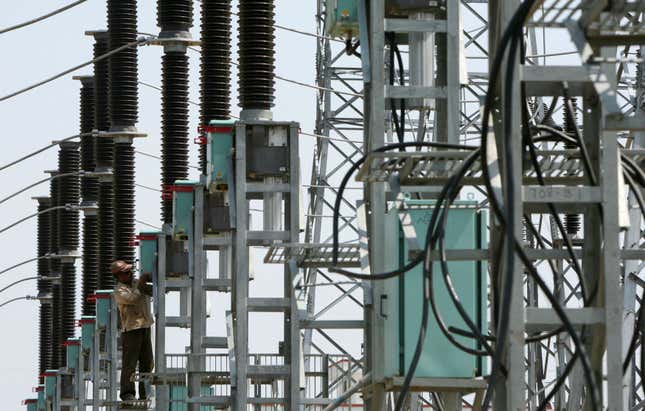
India is bracing for an alarming increase in the number of summer heat waves in coming years, putting lives at risk and leaving the economy scorched. But there is one group that could gain from this torrid scenario: power companies.
Analysts forecast that the 30-odd power-generating companies in India, like Tata Power, NTPC, and CESC, will see a rise in their stock prices amid a surge in demand for electricity in the country. Already, on April 18 this year, demand hit a new high of 216 gigawatts (GW) and this summer is likely to see more records being set.
“With peak demand above 200GW in April and expected to move towards 230 GW as we move ahead, we believe that power sector stocks, especially power generation and electricity exchanges, would benefit,” Manish Chowdhury, head of research at Mumbai-based equity firm Stoxbox, told Quartz.
Why will power firms gain from India’s heat waves?
India’s power firms sell only a portion of the electricity they generate directly to consumers. However, this is a lucrative segment since prices here are not bound by long-term agreements and are more sensitive to demand and supply.
Therefore, when demand for power rises, companies earn better and that reflects on their shares, according to Manoj Dalmia, founder and director at Proficient Equities, a Kolkata-based equity firm.
“Price hikes have already been seen due to increased demand for Adani Electricity residential users, the hike will be 5%. Tata Power, which offers the cheapest tariff for 0-100 unit users, will raise the prices by 10% in 2023-24 and 21% in 2024-25,” Dalmia said.
The worsening heat waves in India are an opportunity for these companies to maximize their earnings.
For instance, in April-May 2022, India experienced its worst power outages in more than six years. Since then, things have improved considerably with the plugging of the gap by the solar power sector.
However, households and industries still face risks, Quartz reported in March. And that is a potential opportunity for power-generating firms.
The heat is only rising and India is unprepared
India’s season of brutal heat waves falls between March and July.
In 2022, India recorded a total of 280 days of heat waves in 16 of its states. India Meteorological Department (IMD) says that by 2060, this will have risen by 12-18 days.
This is a threat not just to agriculture, which contributes up to 20% to India’s economy but even labour hours. For instance, in 2021, India lost 167.2 billion potential labour hours to excessive heat conditions, a Lancet study showed. “The loss of labour hours led to a loss of income which is equal to 5.4% of the country’s GDP,” it noted.
Indian authorities need more resources and efficient plans to manage the crisis, especially among its most vulnerable groups, according to New Delhi-based think-tank, Centre for Policy Research (CPR). India’s 37 regional and federal heat action plans have not been updated regularly and, in most cases, do not have separate budgets, according to a CPR report published in March.
More importantly, existing plans have no legal framework to support and implement them.